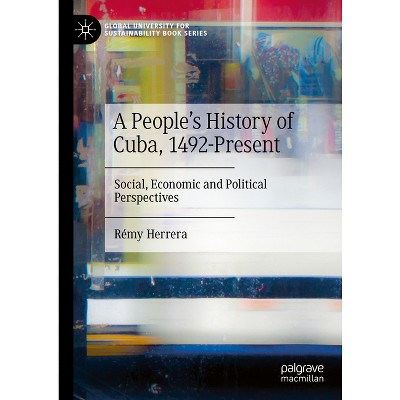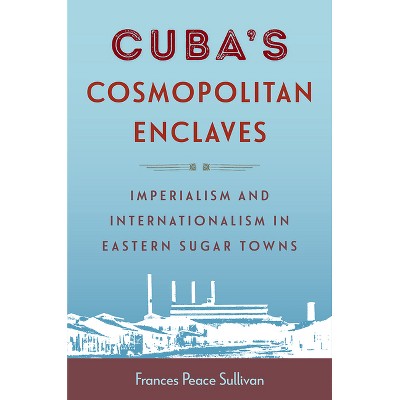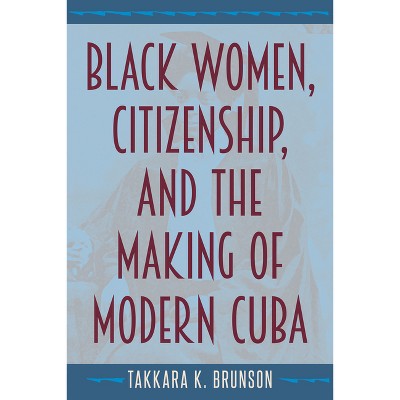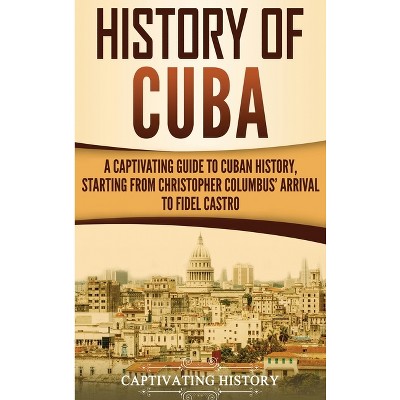Chinese in Cuba, 1847-Now - (Asiaworld) by Mauro García Triana & Pedro Eng Herrera (Hardcover)

$143.00 when purchased online
Target Online store #3991
About this item
Highlights
- This book deals with Chinese immigrants' role in the struggle for Cuban liberation and in Cuba's twentieth-century revolutionary social movement; the history of the Chinese economy in Cuba; and the Chinese contribution to Cuban music, painting, food, sport, and language.
- About the Author: Gregor Benton is professor of Chinese history at the School of History and Archaeology at Cardiff University.
- 298 Pages
- History, Caribbean & West Indies
- Series Name: Asiaworld
Description
About the Book
The Chinese community in Cuba in the nineteenth century was second only in size to that in the United States. This book of essays and documents looks at the community's revolutionary history and its contemporary evolution.Book Synopsis
This book deals with Chinese immigrants' role in the struggle for Cuban liberation and in Cuba's twentieth-century revolutionary social movement; the history of the Chinese economy in Cuba; and the Chinese contribution to Cuban music, painting, food, sport, and language. The centerpiece of the book is a translation of a study by Mauro García Triana and Pedro Eng Herrera on the history of the Chinese presence in Cuba. Over many years, García and Eng have collaborated closely on scholarly research on the Chinese contribution to Cuban life and politics, although their work is not widely known. Both are well equipped for such an enterprise: Eng as a Cuban of Chinese descent and a participant in the ethnic-Chinese revolutionary movement in Cuba, starting in the 1950s; García as a participant in the struggle against Batista and Cuban Ambassador to China during the period of the Cultural Revolution. The study is supplemented by an extensive collection of archival photographs and of paintings on Cuban-Chinese themes by Pedro Eng, who is not just a chronicler of the community but a well-known worker-artist who paints in a style described by commentators as "naive." The volume has three appendices: excerpts from the Cuba Commission's 1877 report on Chinese emigration to Cuba; the rebel leader Gonzalo de Quesada y Aróstegui's pamphlet "The Chinese and Cuban Independence," translated from his book Mi primera ofrenda (My first offering), first published in 1892; and the chapter on "Coolie Life in Cuba" from Duvon Clough Corbitt's Study of the Chinese in Cuba, 1847-1947 (Wilmore 1971).Review Quotes
Given the authors' unique personal experiences and the title, this book will attract readers seeking answers to a major question: why and how did the Cuban Chinese community, a result of migration and hard work of more than one century and once the most active overseas Chinese community in Latin America, cease to exist shortly after the 1959 Cuban Revolution?.... The Chinese in Cuba, 1847-Now stands as a significant contribution to the discussion on Chinese in Cuba up to 1959.... Overall, the book should be recommended to all readers concerned with the connections between East Asia and the Caribbean in the 19th and 20th centuries.
Overall, the essays and appendices included in The Chinese in Cuba, 1847-Now are, undoubtedly, a great source of information on the Chinese presence in Cuba for specialists in the topic.
The Cuban Chinese story has been told as fragments of historical tragedy and growing irrelevance. Gregor Benton has now given us voices that tell us how some Chinese managed to make a difference.
This book is a good resource for scholars researching the history of the Chinese in Cuba. Mauro García Triana, a historian and former Cuban ambassador, and Pedro Eng Herrera, a Cuban artist and writer of Chinese descent, have assembled a wide-ranging compendium of information about the history of the Chinese in Cuba. Covering everything from culture to labour to business, this book contains encyclopedic information on what seems like every detail the authors could gather about the Chinese in Cuba. Those looking for analysis of the materials presented may be disappointed, but it is to be hoped that this work of historical recovery will help others to flesh out the stories of the Chinese in Cuba.
This book is a wonderful example of historical recovery. García and Eng tell the largely forgotten story of the Chinese who came to Cuba in the middle of the nineteenth century to work as coolies. They reveal the remarkable role played by them in Cuba's struggle for independence and for socialism as well as their important contribution to the country's economic development. Above all, they demonstrate the vital input made by the Chinese into forging the vibrant mix of cultures that is modern Cuba, outlining in absorbing detail their influence on music, painting, theatre, food, sport, and language. Gregor Benton offers an enlightening and erudite introduction and the book concludes with some fascinating original documents.
About the Author
Gregor Benton is professor of Chinese history at the School of History and Archaeology at Cardiff University.Dimensions (Overall): 9.0 Inches (H) x 5.9 Inches (W) x 1.0 Inches (D)
Weight: 1.35 Pounds
Suggested Age: 22 Years and Up
Number of Pages: 298
Genre: History
Sub-Genre: Caribbean & West Indies
Series Title: Asiaworld
Publisher: Lexington Books
Theme: Cuba
Format: Hardcover
Author: Mauro García Triana & Pedro Eng Herrera
Language: English
Street Date: February 16, 2009
TCIN: 1004111765
UPC: 9780739133439
Item Number (DPCI): 247-23-3021
Origin: Made in the USA or Imported
If the item details above aren’t accurate or complete, we want to know about it.
Shipping details
Estimated ship dimensions: 1 inches length x 5.9 inches width x 9 inches height
Estimated ship weight: 1.35 pounds
We regret that this item cannot be shipped to PO Boxes.
This item cannot be shipped to the following locations: American Samoa (see also separate entry under AS), Guam (see also separate entry under GU), Northern Mariana Islands, Puerto Rico (see also separate entry under PR), United States Minor Outlying Islands, Virgin Islands, U.S., APO/FPO
Return details
This item can be returned to any Target store or Target.com.
This item must be returned within 90 days of the date it was purchased in store, shipped, delivered by a Shipt shopper, or made ready for pickup.
See the return policy for complete information.











